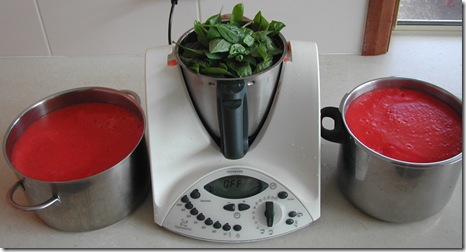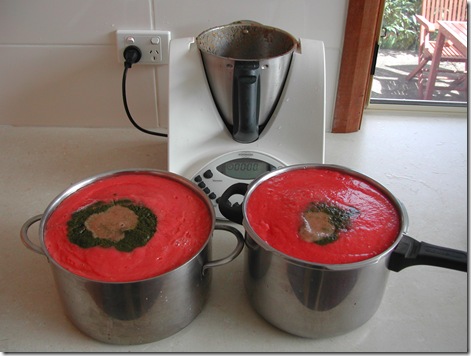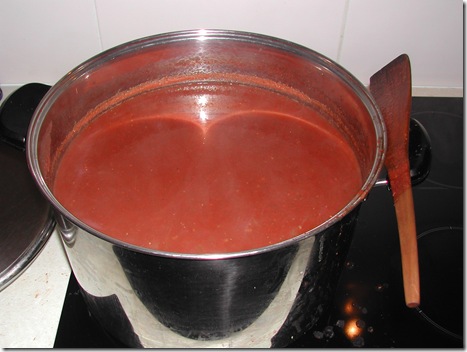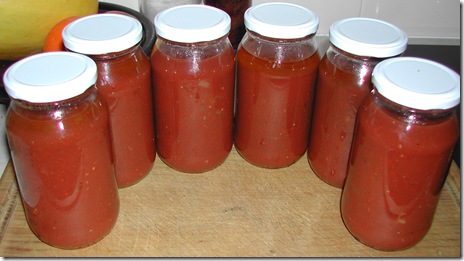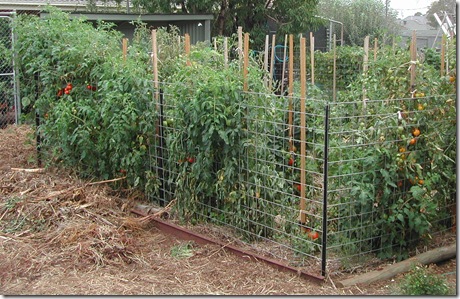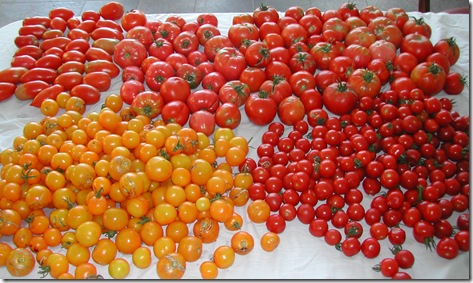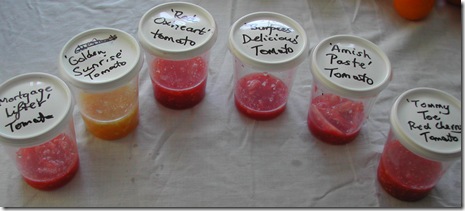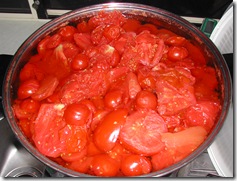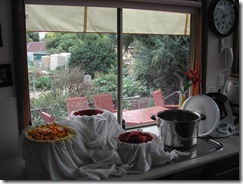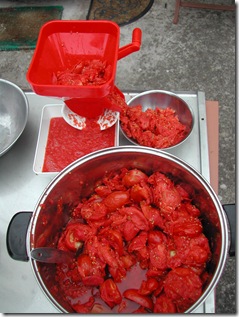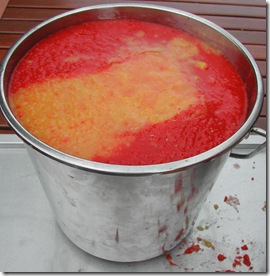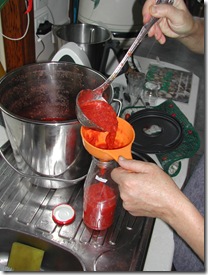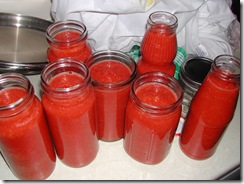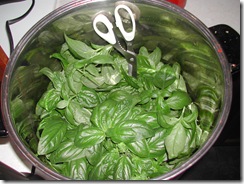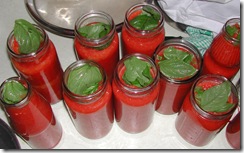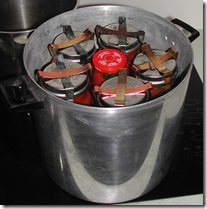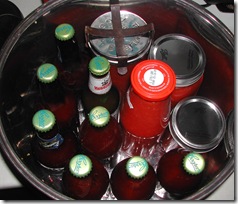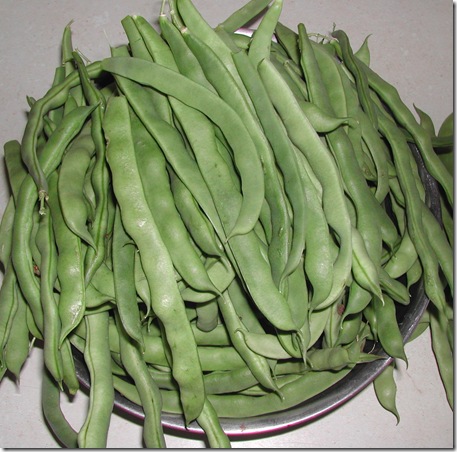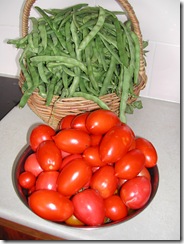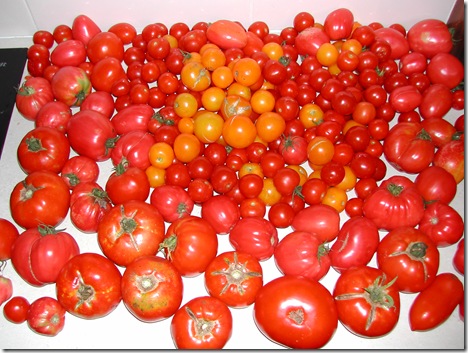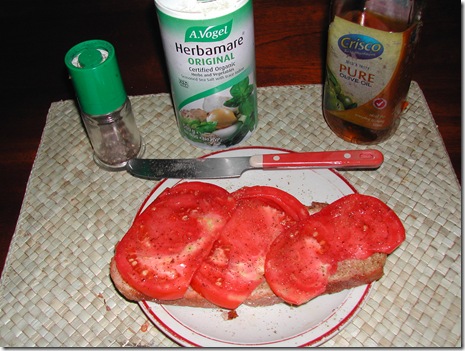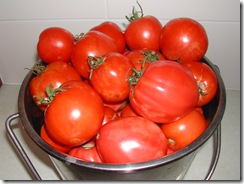 The cook has arrived safely in the Fatherland to look out for the ‘oldies’ for a while, leaving the gardener behind as caretaker of her Australian domain. With the tomatoes still producing at the rate of a few bucketfuls per week, and autumn plantings in full swing out in the garden, desperate measures are required to ram these tomatoes through the understaffed bottling department. Not only that, the tomato press has been leant out to our middle son, so all the technology and expertise built up by the gardener as ‘cook’s helper’ has been decimated in two swift moves…
The cook has arrived safely in the Fatherland to look out for the ‘oldies’ for a while, leaving the gardener behind as caretaker of her Australian domain. With the tomatoes still producing at the rate of a few bucketfuls per week, and autumn plantings in full swing out in the garden, desperate measures are required to ram these tomatoes through the understaffed bottling department. Not only that, the tomato press has been leant out to our middle son, so all the technology and expertise built up by the gardener as ‘cook’s helper’ has been decimated in two swift moves…
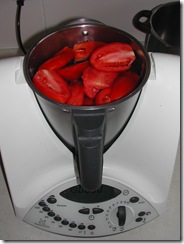 Fortunately, not all things German have taken the Qantas flight to the other side of the world; the Thermomix has been left on the kitchen benchtop, where it holds pride of place at the heart of the cook’s domain. Perhaps it was a measure of the cook’s desperation at this untimely desertion in the middle of harvest, but her last words before boarding her flight were something about ‘halve the tomatoes, leave the skins on and use the Thermomix to puree them’. Strewth! – despite three engineering degrees and 36 years at the high-tech coalface, the gardener has never before been entrusted with the charge of this sacred artefact and so many inscrutable buttons. Nevertheless, with the addition of some freshly-picked basil, here’s how it went…
Fortunately, not all things German have taken the Qantas flight to the other side of the world; the Thermomix has been left on the kitchen benchtop, where it holds pride of place at the heart of the cook’s domain. Perhaps it was a measure of the cook’s desperation at this untimely desertion in the middle of harvest, but her last words before boarding her flight were something about ‘halve the tomatoes, leave the skins on and use the Thermomix to puree them’. Strewth! – despite three engineering degrees and 36 years at the high-tech coalface, the gardener has never before been entrusted with the charge of this sacred artefact and so many inscrutable buttons. Nevertheless, with the addition of some freshly-picked basil, here’s how it went…
Now what, you say?
Stir? freeze? bottle? boil?
Dunno! – I’d better send the cook an SMS and ask – she knows I can’t remember more than three instructions at a time…
Some hours later
Dawn has awoken the cook; nine and a half hours ahead on the opposite side of the globe, the gardener is starting to fade, as is the late afternoon sunlight over the kitchen garden. Instructions filter through – add chopped onion, sea salt, garlic, cook slowly, bottle or find someone with freezer space…
Every large saucepan from the cupboard is now sauce-coated and out on the workbench; this calls for a trip to the cellar to fetch a serious pan; there’s about 15 litres of tomato puree here from one bucket of tomatoes. Slow cooking overnight reduces this volume slightly by boiling off excess water and thickening the puree. It also serves to keep the sauce near boiling point overnight, and stops it starting to ferment before I can find a solution to the bottling business.
Another sunrise over Australia, and its Monday; a working day – but not in the garden. Luckily for me, cooks outnumber gardeners ten-to-one in modern life; I call a friend who’s been keen to get some home-grown tomatoes to make sauce with, and tell her that the back door’s open and the sauce is already made and piping-hot on the stove. She runs around, buys new jars, sterilizers them and fills them with sauce. There’s so much left over that she turns some of it into a lasagne for my number one son and I that evening. I get half-a-dozen bottles of sauce; these will go to my third son and his wife for their newly-wed larder.
But the saga doesn’t end there; Sunday lunch in the middle of this process was all a bit rushed, and so our barbequed kangaroo was supplemented by some hot chips from the local chicken shop. Behind the counter was a young Chinese lady we have come to know who lives in a pokey little flat, without a garden, down the end of our street. I offer to drop off a bag of fresh vegetables – tomatoes, eggplant, chives, chillies, Chinese cabbage and so forth. Somehow, I fit that in too, and then forget about it. Monday evening finds her knocking on the door with a roast chicken from the shop; she and her flatmate have been thrilled to have fresh vegetables to include in their own cooking.
So then, our bachelor supper on Tuesday night will be chicken cacciatore. I have the sauce and the chicken, home-grown olives, and all the ingredients for a fresh salad just outside the back door…

